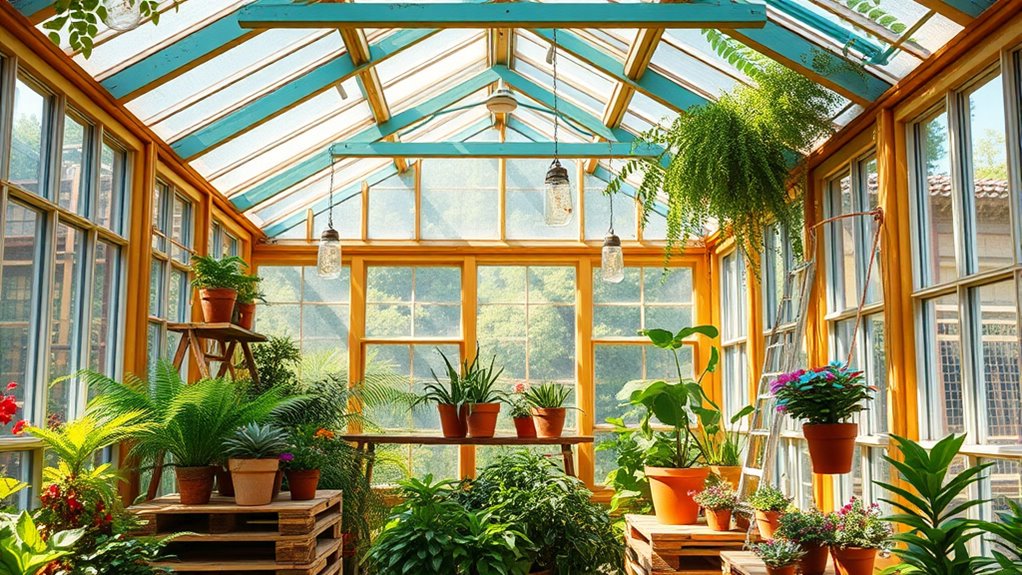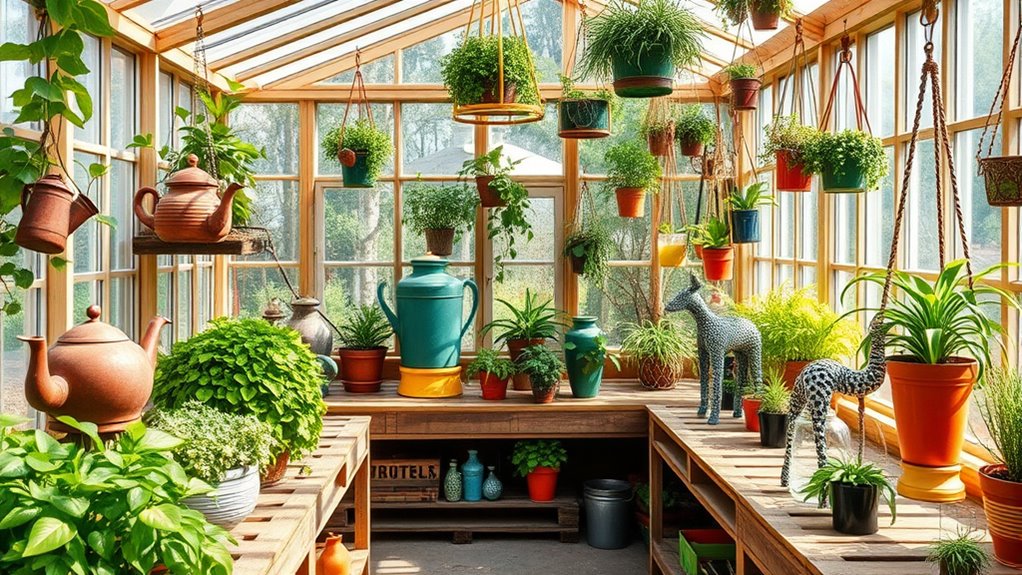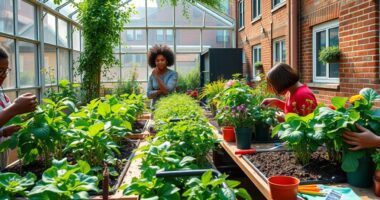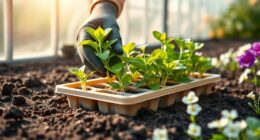To creatively upcycle and decorate your greenhouse, utilize old pallets for shelving, vintage crates as plant containers, and repurpose glass jars for herbs or succulents. Transform unused windows into mini greenhouses or wall displays, and use reclaimed wood, stones, or driftwood for pathways and accents. Incorporate string lights or lanterns for ambiance, adding a charming, eco-friendly vibe. If you keep exploring, you’ll discover even more inspiring ways to personalize your greenhouse sustainably.
Key Takeaways
- Use reclaimed materials like pallets, vintage crates, and old windows for sustainable, rustic greenhouse construction and decor.
- Incorporate repurposed items such as ladders, metal drums, and natural elements to create a personalized, eclectic environment.
- Enhance lighting and space perception with reflective surfaces like mirrors and shiny metal accents.
- Add ambiance with upcycled string lights, lanterns, and natural accents like stones or driftwood.
- Follow sustainable principles by reducing waste, supporting eco-friendly practices, and fostering a vibrant, resourceful garden space.

Ever wondered how to maximize your gardening space and grow plants year-round? Creating a greenhouse that’s both functional and stylish doesn’t have to mean spending a fortune. Instead, you can embrace upcycling and clever decorating ideas to transform your space into a vibrant, eco-friendly haven. Indoor gardening becomes more accessible and sustainable when you incorporate sustainable design principles, using repurposed materials that reduce waste and add character to your greenhouse. Think about old pallets for shelving, vintage crates for plant containers, or repurposed glass jars for herbs and succulents. These choices not only save money but also give your greenhouse a unique charm, blending practicality with eco-consciousness. Upcycling is a fantastic way to personalize your greenhouse while supporting sustainable practices. For example, unused windows can be turned into mini greenhouses or wall-mounted plant displays. Old wooden ladders make excellent multi-tiered plant stands, perfect for maximizing vertical space and creating visual interest. You can also turn discarded metal drums into planters or compost bins, giving new life to materials that might have otherwise been thrown away. These ideas help you make the most of limited space and create a layered, dynamic environment that encourages plant growth all year. Plus, by choosing sustainable design elements, you’re making a conscious effort to reduce your carbon footprint while cultivating a lush, productive environment. Additionally, incorporating workaholic tendencies and balancing personal pursuits can influence how much time and effort you dedicate to your gardening projects, fostering a mindful approach to sustainability and growth. Decorating your greenhouse with upcycled items doesn’t mean sacrificing style. In fact, it adds a rustic, eclectic vibe that’s both inviting and inspiring. Add string lights or vintage lanterns for ambient lighting, or hang decorative items from reclaimed wood beams to enhance the aesthetic. You can also incorporate natural materials like stones, driftwood, or bamboo to create pathways and accents that blend seamlessly with your plants. Incorporate reflective surfaces such as mirrors or shiny metal accents to boost light and make your space feel larger and brighter. These touches not only beautify your greenhouse but also promote a sustainable approach to design, reducing reliance on new materials and emphasizing creativity. Incorporating upcycled decor and sustainable design into your greenhouse transforms it from a simple gardening space into a personalized retreat. It encourages you to think resourcefully about how everyday items can serve a new purpose. With a bit of effort and imagination, you’ll cultivate a vibrant, eco-friendly environment that supports indoor gardening all year long while reflecting your style and commitment to sustainability. This approach not only saves money but also fosters a deeper connection to nature and your environment, making your greenhouse a true reflection of your passion for plants and the planet.
Frequently Asked Questions
What Eco-Friendly Materials Are Best for Greenhouse Upcycling Projects?
When choosing eco-friendly materials for your greenhouse upcycling projects, recycled metals are a great option because they’re durable and reduce waste. Biodegradable plastics are also ideal since they break down naturally, minimizing environmental impact. You can repurpose these materials for framing, plant pots, or decorative elements. Using recycled metals and biodegradable plastics helps you create a sustainable, eco-conscious space that benefits both your plants and the planet.
How Can I Improve Natural Light in a Small Greenhouse?
You might worry that a small greenhouse limits natural light, but you can maximize it by using hanging plant displays to free up space and reflect light. Additionally, explore natural ventilation options like adjustable vents or open sides to prevent shading and enhance brightness. These strategies boost sunlight exposure, making your greenhouse more vibrant and productive without needing extra artificial lighting, creating an inviting, lush environment.
What Are Cost-Effective Ways to Insulate a Greenhouse?
To insulate your greenhouse cost-effectively, consider adding thermal curtains at night to trap heat and reduce energy loss. You can also use bubble wrap or reflective insulation on the windows and walls, which helps retain warmth. Incorporating solar heating options, like passive solar design or solar panels, boosts insulation by harnessing free sunlight. These simple, affordable methods keep your greenhouse warmer without breaking the bank.
How Do I Attract Pollinators to My Greenhouse?
Attracting pollinators to your greenhouse is like opening a welcoming door to nature’s busiest workers. Plant pollinator-friendly plants, such as lavender and bee balm, to entice bees and butterflies. Create habitat diversity with native flowers, shrubs, and nectar sources. Avoid pesticides, provide water sources, and add bee hotels for shelter. These steps turn your greenhouse into a bustling hub of pollination, boosting your plants’ health and productivity naturally.
What Safety Precautions Should I Take When Decorating a Greenhouse?
When decorating your greenhouse, you should prioritize safety by wearing appropriate safety gear like gloves and goggles to prevent injuries. Be aware of hazards such as sharp tools, unstable structures, or toxic materials. Keep your workspace organized to avoid accidents, and always handle decorations carefully. By maintaining hazard awareness and using proper safety gear, you create a safe environment where you can enjoy decorating without risking harm.
Conclusion
Think of your greenhouse as a blank canvas waiting for your personal touch. With a little upcycling and creative decorating, you’re sculpting a vibrant oasis from everyday objects. Your space becomes a living masterpiece, blending nature and artistry seamlessly. So, don’t hold back—let your imagination run wild and turn your greenhouse into a sanctuary that reflects your unique style. After all, it’s your masterpiece in the making, ready to flourish with love and creativity.









